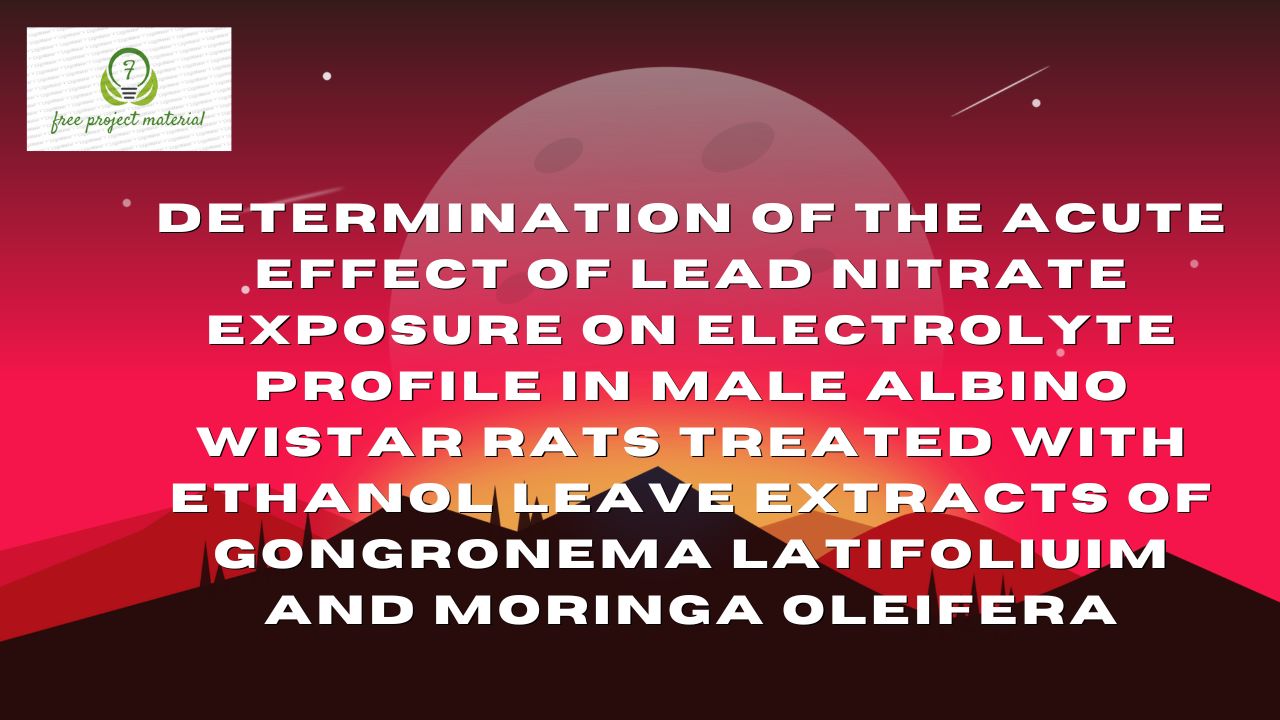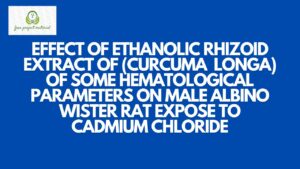ABSTRACT
Acute impact of lead nitrate exposure on electrolute profile in male albino wistar rats treated with ethanolic leave extacts of G. latifolium and M. oleifera was determined. Twenty (20) animals weighing 94.25-125.50g were randomly grouped into five groups of four rats each. Groups 1 – 4 were exposed orally to 30% below the LD50 of lead nitrate [Pb(NO3)2] before treatment. Groups 1 and 2 were later treated with 500mg/kg ethanol leave extracts of G. latifolium and M. oleifera respectively. Group 3 was treated with 500mg/kg of the two leave extracts at 50:50 dosage ratio. Groups 4 and 5 were not treated and served as positive and normal control groups respectively. The treatment was done daily via oral route for 14 days and the animals were fed with commercial rat mash and water throughout the period of treatment. At the end of the experiment, no significant difference (P>0.05) was observed in serum bicarbonoic (HCO3–), sodium (Na+), Potassium (K+) and chloride (Cl–) ions levels between groups of animals. A non-significant increase (P>0.05) in serum HCO3– level in the positive control group (group 4) was observed when compared to group 1, 2, 3 and normal control group (group 5). A non-significant decrease (P>0.05) in serum HCO3– and Cl– levels were found in group 5 when compared to groups 1, 2, 3 and positive control group. A non-significant increase (P>0.05) in serum HCO3– and Na+ levels in groups 1 and 5 when compared to groups 2, 3 and 4. Serum K+ showed a non-significant increased (P>0.05) in groups 2 and 5 when compared to groups 1, 3 and 4 respectively. The results of these findings implied that though there was no significant difference in serum HCO3–, Na+, K+, and Cl– levels in the study animals, lead nitrate impacted certain level of toxic influence on the electrolyte profile which might have been ameliorated by the efficacy of the ethanol leaves extracts treatment on the animals.
TABLE OF CONTENTS
TITLE PAGE – – – – – – – – i
CERTIFICATION – – – – – – – – ii
DEDICATION – – – – – – – – iii
ACKNOWLEDGEMENT – – – – – – iv
ABSTRACT- – – – – – – – – v
TABLE OF CONTENTS – – – – – – – vi
CHAPTER ONE: INTRODUCTION
1.1 Background of the Study – – – – – – 1
1.2 Aim and Objectives of the Study – – – – 7
1.3 Scope and Limitations of the Study – – – – 8
CHAPTER TWO: LITERATURE REVIEW
2.1 Description of the Plants – – – – – – 9
2.1.1 Description of Gongronema latifolium Plant – – – 9
2.1.2 Description of Moringa oleifera Plant – – – – 10
2.2 Origin and classification of the Plants – – – – 14
2.2.1 Origin and classification of the Gongronema
latifolium Plant – – – – – – – 14
2.2.2 Origin and Classification of the Moringa oleifera Plant – 15
2.3 Nutritional Profile of the Plants – – – – – 16
2.3.1 Nutritional Profile of Gongronema latifolium Plant – 16
2.3.2 Nutritional Profile of Moringa oleifera Plant – – – 17
2.4 Medicinal values of the Plants – – – – – 20
2.4.1 Medicinal values of Gongronema latifolium Plant – – 20
2.4.2 Medicinal values of Moringa oleifera Plant – – – 21
2.5 Phytochemicals composition of the Plants – – – 23
2.5.1 Phytochemical composition of Gongronema
latifolium Plant – – – – – – – 23
2.5.2 Phytochemical composition of Moringa oleifera Plant – 24
2.6 Electrolyte Profile – – – – – – – 26
2.7 Effect of Heavy Metal Toxicity on Electrolyte Profile – 29
CHAPTER THREE: MATERIALS AND METHODS
3.1 Materials and Reagents – – – – – – 33
3.1.1 Collection of Plant Samples – – – – – 33
3.1.2 Preparation of Plant Samples – – – – – 34
3.1.3 Purchase and Preparation of Heavy Metal – – – 35
3.1.4 Experimental Design, Grouping of Animals to the
Heavy Metal and Treatment of Animals – – – 36
3.1.5 Collection of Blood Samples and Preservation of the Serum- 37
3.2 Methods – – – – – – – – 38
3.2.1 Determination of Sodium (Na+) – – – – – 38
3.2.2 Determination of Potassium (K+) – – – – 38
3.2.3 Determination of Chlorine (Cl–) – – – – – 38
3.2.4 Determination of Bicarbonate (HCO32-) level – – 39
3.3 Statistical Analysis – – – – – – – 39
CHAPTER FOUR: RESULTS AND DISCUSSION
4.1 Results – – – – – – – 40
4.2 Discussion – – – – – – – – 42
CHAPTER FIVE: CONCLUSION AND RECOMMENDATIONS
5.1 Conclusion – – – – – – – – 46
5.2 Recommendations – – – – – – – 46
References
CHAPTER ONE: INTRODUCTION
1.1 Background of the Study
Contamination of heavy metals in the environment is a major global concern because of toxicity and threat to the human life and ecosystem. The level of metals and its toxicity is increasing in all states of environment pose serious threat to health and ecosystems. One of the earliest metals discovered by the human population is Lead (Pb). It has a number of unique properties such as low melting point, ductility, high malleability, resistance to corrosion and low cost (Kalia and Flora, 2005). This has made its widespread usage in different industrial sectors which in turn has led to its manifold occurrence in free form in the environment. During that time hazardous effects of lead was not considered but recent years the effects of lead toxicity become worst. At the same time because of its non-biodegradable nature, it is considered as potent hazardous toxins and causes serious health issues to people (Kalia and Flora, 2005).
Lead is a non-essential and toxic metal that occurs ubiquitously in the environment. Lead is ranked second in the list of prioritized hazardous substances by the Agency for toxic substances and Disease Registry (ATSDR, 2019). Lead exposure accounts for 0.6% of the global burden of disease with a higher burden in developing countries (WHO, 2009). Low-income communities are more susceptible to environmental pollution (Miranda et al., 2009). Kidney and liver disorder due to lead toxicity are well known and studied (Sabath and Robles-Osorio, 2012). Haematotoxicity from lead exposure is caused by impeding haemoglobin synthesis by inhibiting a key enzyme, β-amino levulinic acid dehydratase (ALAD) and by shortening the life span of erythrocutes (Gonick, 2011). Since oxidative stress induction is on important mechanism underlying lead toxicity, measurement of the markers relating to it such as 8-OHdG) and protein carbonyl have been commonly used in previous studies regarding the assessment of lead toxicity assessment (Aladaileh et al., 2020).
Chelation therapy using dimercaptosuccinic acid (DMmsMA) is currently the most reliable medical treatment for lead poisoning (Van Eijkeren et al., 2017). However, it is not affordable for patients in developing countries possible side effects, including renal failure, tetany, hypotension and respiratory arrest are also a concern in case of long-term use for chronic exposure (Lowry, 2010). Therefore, various alternative treatment methods with fewer adverse health effects and lower cost have been studied (Nakata et al., 2012).
Moringa oleifera (MO) which belongs to the Moringaceace family is widely cultivated in tropical and subtropical areas world-wide because of its fast growing and drought resistant properties. MO contains higher levels of essential minerals such as zinc, calcium and phosphorus than do readily available vegetables (Rockwood et al., 2013). Because of its ease of cultivation, MO is used to treat malnourished children (Kasolo et al., 2010). Moreover, various medicinal benefits have been attributed to its leaves and seeds (Falowo et al., 2018). In particular some phytochemical compounds such as Kaempferol and glucomoringin isothiocyanate in MO have potent antioxidant properties and are known to prevent cell death or organ damage due to a reduction in oxidative stress (Calderron-Montano et al., 2018). Some in vivo studied demonstrated an improvement of lead-induced hepatic injury due to antioxidant effect of MO leaf aquatic extracts and methanolic extracts, similar protective effects from MO extracts for renal damage have been reported (Abdel-Daim et al., 2020), another study reported protective effects of ethanolic extract of MO on lead-related haematotoxicity including reduction of haemoglobin levels and erythrocytes
Another study reported protective effects of ethanolic extracts of MO on lead-related haematotoxicity including reduction of haemoglobin levels and erthrocyctes (Owolabi et al., 2012).
Gongronema latifolium Benth is a perennial edible plant with soft and pliable stem. It is widely used in West African sub-region for a number of medicinal and nutritional purposes. It belongs to the family of Asclepiadaceae. Gongronema latifolium Benth (whose leaves are bitter) is commonly called “utazi” and “arokeke” in south Eastern and South Western parts of Nigeria respectively. It is a tropical rainforest plant primarily used as a spice and vegetable in traditional folk medicine.
According to Nwanjo et al. (2006) Phytochemical studies of Gongronema latifolium leaves show the presence of Glycosides, Alkaloids, Saponin, Tanin and Flavonoids (Egbung et al., 2011) Micronutrients and Phyto-chemical composition of root bark and twig extracts of Gongronema latifolium was reported to be presence with phyto-chemicals (Tannins, Saponnins, Alkaloids, flavonoids and hydrocyanide), mineral elements (Cr, Cu, Se, Zn and Fe) and Vitamins (A, C, Riboflavin, Niacin and thiamine). However, the concentration of these phytochemicals varies among these plant parts.
Tiwari and Roa (2002) reported that the different composition of the active compounds in plants give medicinal plants an edge as better therapeutic agent than chemotherapy in management of different ailments such as atherosclerosis, hypertension and diabetes.
A cold infusion of the pounded stem of Gongronema latifolium is used to manage colic and intestinal symptoms usually associated with worms. The leaves are used to prepare food for nursing mothers, where it is believed to stimulate appetite, reduce post-partum contraction and enhance the return of the menstrual cycle. Gongronema latifolium possesses hypoglycemic activity, hypotensive, hepaprotective and hypolipidemic effect (Ugochukwu and Babady, 2003).
Electrolytes play significant role in several body processes, such as controlling fluid levels, acid-base balance (pH) nerve conduction, coagulation and muscle contraction (Hasona and Elasbali, 2016). Fluid and electrolyte homeostasis is usually maintained within narrow limits (Roberts, 2005) and therefore, it must be kept at a level that is suitable for normal biochemical and physiological function (Kaneko et al., 2008). Therefore, imbalance in serum electrolyte is an important indicator of pollution in identifying target organs and general health status of animals (Shaista et al., 2010).
Interest in medicinal plant as a re-emerging health aid in the maintenance of personal health and well-being has been fuelled by rising cost of prescription drugs and the bioprospecting of new plant derived drugs (Sharma et al., 2010). This have sparked remarkable surge of interest in chemoprevention research which has led to the identification of many phytochemicals or dietary origin as effective and potential chemo-preventive agents (Bharali et al., 2003). Researchers have explored the possible used of medicinal plants with antioxidant activity in protection against heavy metal toxicity (El-Nekeety et al., 2009). Moringa oleifera was demonstrated not only to suppress formation but even have a strong free radical scavenging effect (Ogbunugafor et al., 2011).
1.2 Aim and Objectives of the Study
Aim of the Study
The aim of this research work is to determine the effect of lead nitrate exposure on the electrolyte profile in male albino Wistar rats treated with ethanol leave extracts of Gongronema latifolium and Moringa oleifera.
Objectives of the Study
The following were the objectives of this research
- To determine the serum level of bicarbonate (HCO3–),
- To evaluate the serum level of sodium (Na+),
- To investigate the serum level of potassium (K+), and
- To assay the serum level of chloride (Cl–) in albino Wistar rats exposed to lead nitrate and treated with ethanol leaves extracts of Gongronema latifolium and Moringa oleifera.
1.3 Scope and Limitations of the Study
The scope of this study covers the determination of serum electrolytes levels of male albino rats exposed to lead nitrate and treated with ethanol leaves extracts of Gongronema latifolium and Moringa oleifera. However, the high cost of materials, high financial implication and time constraint were the limitations of this research work.


